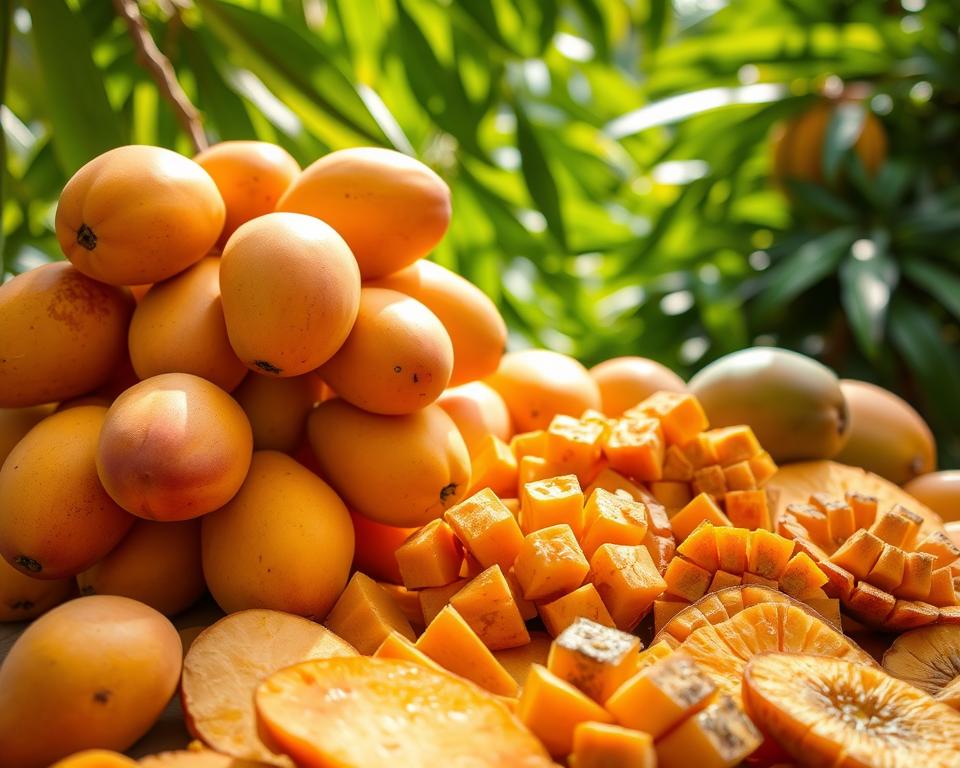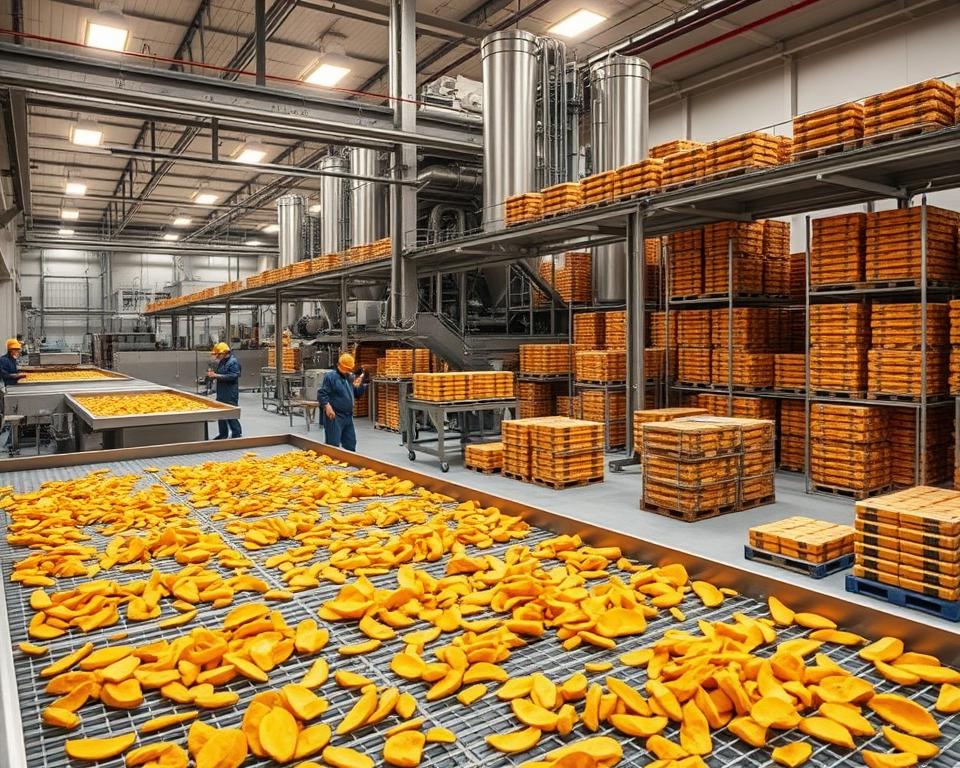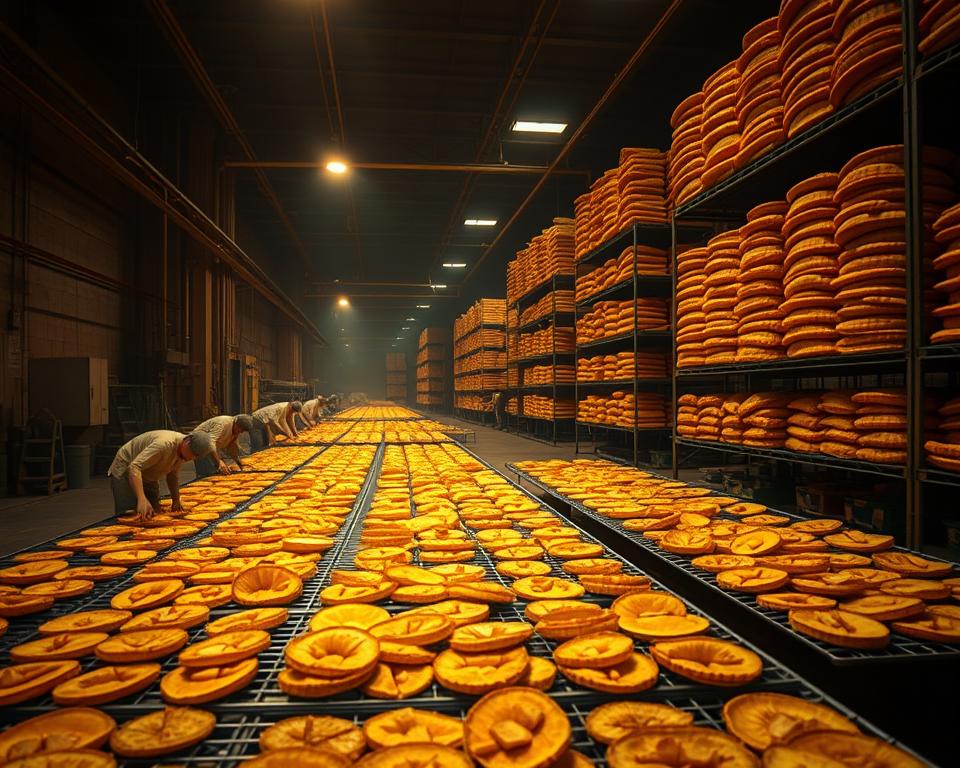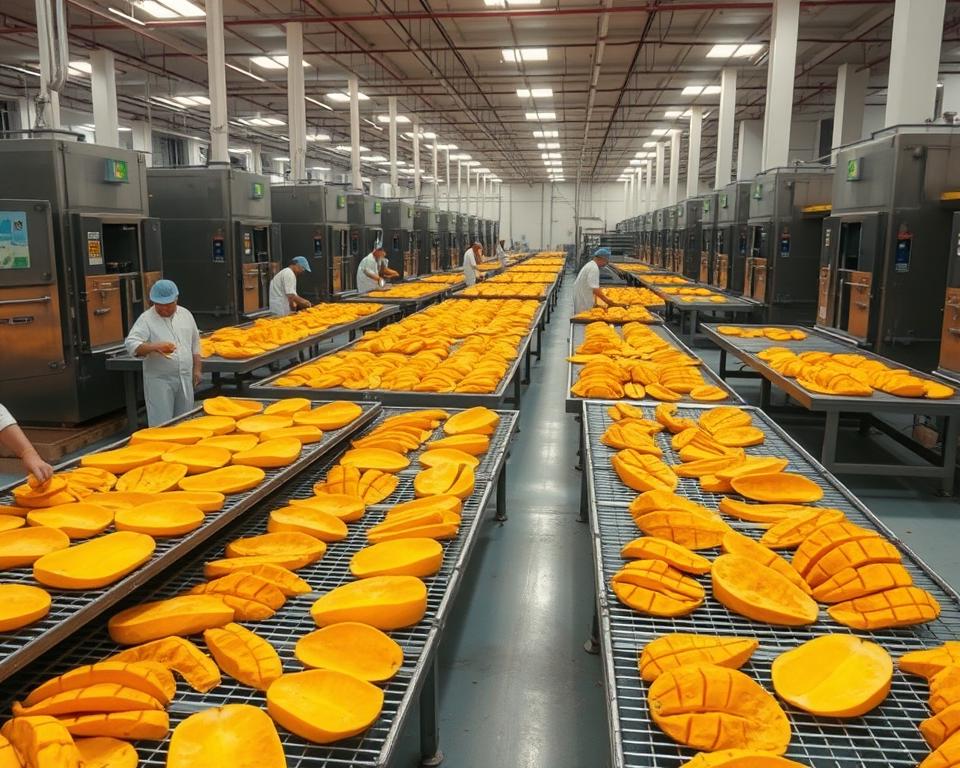The making of dried mango is a detailed process. It turns fresh mangoes into a tasty and healthy snack. The journey starts with picking the best mangoes. Then, they go through many steps to become the dried mango we love.
Learning about the production process shows the hard work in making dried mangoes. For a full view, check out a guide on dried mango production. It explains everything from washing and peeling to drying and packaging.
Key Takeaways
- The production process involves several stages from sourcing fresh mangoes to packaging.
- Mangoes are sorted based on size, quality, and ripeness before processing.
- Drying methods include hot air drying and freeze drying to preserve flavor and nutrients.
- Quality control checks ensure the dried mango meets the factory’s standards.
- Airtight packaging protects the dried mango from moisture and contamination.
The Dried Mango Industry in Vietnam
Vietnam is a big player in the global dried fruit market. Its dried mango industry is a key part of this success. The country’s good climate and growing demand from abroad help a lot.
Economic Impact and Regional Production Hubs
The dried mango factory is very important for Vietnam’s economy. It helps a lot of people in rural areas. The Mekong Delta and southern regions are the main places for mango farming.
Vietnam’s Position in the Global Dried Fruit Market
Vietnam is a top exporter of dried fruits. Its mango products are popular because of their quality and price.
Export Statistics and Growth Trends
Export numbers for Vietnam’s dried mango have been going up. There’s been a big increase in demand from Asia, Europe, and North America.
| Year | Export Volume (tons) | Growth Rate (%) |
|---|---|---|
| 2020 | 10,000 | – |
| 2021 | 12,000 | 20% |
| 2022 | 15,000 | 25% |
Key International Markets
Vietnam sends its dried mango to many places. The European Union, the United States, and Asia are big buyers.
Mango Varieties Used for Drying in Vietnam
In Vietnam, mango drying focuses on Cat Hoa Loc and Cat Chu. These mangoes are chosen for drying because of their special qualities.
Characteristics of Preferred Varieties
The Cat Hoa Loc and Cat Chu mangoes are loved for their high sugar and strong fiber. This makes them perfect for drying.
Optimal Characteristics for Processing
Several things make mangoes great for drying:
- Sugar Content: High sugar makes dried mangoes taste better and feel softer.
- Fiber Structure: A firmer texture is better because it stays strong during drying.
Sugar Content and Fiber Structure
Mangoes with more sugar get sweeter when dried. Their fiber must be strong to stay firm after drying.
Ripeness Indicators
It’s important to pick ripe mangoes. Too green ones lack flavor, and too ripe ones are too soft.

Raw Material Sourcing and Quality Control
Finding top-quality mangoes is key for making great dried mango. Factories in Vietnam team up with local farmers. This way, they get a steady flow of the best mangoes.
Supplier Relationships with Local Farmers
It’s vital to have strong ties with local farmers. This helps get the best raw materials. Here’s how:
- Regular talks to know what farmers need and face
- Teaching farmers how to grow mangoes the best way
- Setting up contract farming to help farmers earn well
Contract Farming Arrangements
Contract farming helps farmers earn reliably. It also makes sure mangoes are always of high quality. The deal outlines how mangoes will be grown, their quality, and price.
Seasonal Considerations
Mango supply changes with the seasons. Factories prepare by:
- Storing mangoes when they’re plentiful
- Working with many farmers to manage risk
Initial Quality Assessment Procedures
When mangoes arrive, factories check their quality first. They look at:
- How ripe and undamaged the mangoes are
- Testing for sugar and other quality factors
These steps help dried mango factories in Vietnam make top-notch products. They meet global quality standards.
Pre-Processing Operations
Pre-processing is key in making dried mangoes. It prepares the mangoes for drying. This affects the quality of the dried mangoes.
Receiving and Sorting
Mangoes arrive at the factory and are sorted. They are sorted by variety, ripeness, and quality. This sorting is important for a consistent final product.
Washing and Sanitizing Protocols
Mangoes are then washed and sanitized. This removes dirt, bacteria, and contaminants. It’s essential for the safety and cleanliness of the dried mangoes.
Manual Inspection Processes
After washing, mangoes are checked by hand. They are looked at for defects and sorted by ripeness.
Defect Identification
Inspectors find bruises, cuts, and spoilage. Any bad mangoes are taken out of the line.
Ripeness Classification
Mangoes are sorted by how ripe they are. Only the ripest are used next.
- Receiving and sorting of mangoes
- Washing and sanitizing to remove contaminants
- Manual inspection for defects and ripeness classification

Mango Preparation Techniques
Making dried mangoes involves peeling, slicing, and removing seeds. These steps are key to getting a great product. The way you do these steps can change the taste, texture, and quality of the dried mangoes.
Peeling Methods: Manual vs. Mechanical
There are two ways to peel mangoes: by hand or with machines. Peeling by hand is hard work but lets you control the process better. It helps avoid waste and keeps the fruit whole. Machines peel faster and are better for big batches.
Slicing and Size Standardization
After peeling, mango slices are made the same size. This makes sure they dry evenly. The size of the slices depends on what you want the final product to be like. Keeping the sizes the same is important for consistent quality.
Seed Removal Process
Removing mango seeds is a key step done by machines. Seeds are not good to eat and can mess up the drying and texture of the mangoes.
Waste Management and By-product Utilization
Managing waste well is important in mango processing. The peels and seeds can be used for animal food or making special compounds.
| Preparation Step | Method | Importance |
|---|---|---|
| Peeling | Manual/Mechanical | Reduces waste, preserves fruit integrity |
| Slicing | Mechanical | Ensures even drying, size standardization |
| Seed Removal | Mechanical | Improves drying process, final product texture |
Inside a Dried Mango Factory: Equipment and Technology
In a dried mango factory, fresh mangoes turn into dried treats. This magic happens thanks to advanced machines. The mix of old and new methods makes sure the mangoes are top-notch.
Key Processing Equipment
The factory has special machines for each step. These include:
- Washing systems to clean the mangoes
- Cutting machinery for slicing and dicing
- Drying units that use heat and air to dry the mangoes
Washing Systems
Washing systems get rid of dirt and germs. Modern tech makes sure the mangoes are clean without harm.
Cutting Machinery
Cutting machines make mango slices or cubes. They work fast and well, saving fruit and making pieces the same size.
Drying Units
Drying units are key for drying mango slices. They use heat and air to keep the mangoes tasty and healthy.

Automation vs. Manual Processing in Vietnamese Facilities
Vietnamese factories are using more automation. This makes things faster and more even. But, some steps are done by hand. This is for checking quality and doing delicate tasks.
| Processing Method | Advantages | Disadvantages |
|---|---|---|
| Automation | High efficiency, consistent quality | High initial investment, less flexible |
| Manual Processing | Flexible, good for quality control | Labor-intensive, variable quality |
Recent Technology Innovations
For the latest on mango processing tech, check out new drying methods and tools.
Drying Methods and Techniques
The drying process is key in making dried mango. It affects the mango’s quality and how long it lasts. In Vietnam, makers use different drying methods to get the right texture and taste. They also try to keep the mango’s nutrients.
Traditional Sun Drying in Rural Operations
In some rural areas of Vietnam, sun drying is used. Mango slices are spread out to dry in the sun. This method is cheap but depends on the weather. It can also be hard to keep clean and consistent.
Modern Dehydration Technology
Most dried mango makers now use modern dehydration tech. This includes many methods that let them control drying better.
Hot Air Drying Systems
Hot air drying is common in Vietnam’s mango industry. It uses hot air to dry mango slices. This keeps the color and taste good. The temperature and air flow can be set to get the same results every time.
Freeze-Drying Applications
Freeze-drying, or lyophilization, is a more advanced method. It freezes mango slices and then removes moisture in a vacuum. This method keeps the mango’s nutrients and texture but uses a lot of energy and costs more.
Temperature and Humidity Control Parameters
It’s important to control temperature and humidity, no matter the drying method. Mango drying usually happens between 50°C to 70°C. Low humidity helps remove moisture.
Drying Time and Quality Indicators
The time it takes to dry mangoes varies. It depends on the method and how dry you want the mango. Good dried mango is chewy, keeps its color, and rehydrates well.
| Drying Method | Temperature Range | Drying Time | Quality Indicators |
|---|---|---|---|
| Traditional Sun Drying | Ambient | 2-5 days | Variable texture, possible contamination |
| Hot Air Drying | 50°C – 70°C | 6-12 hours | Consistent texture, good color |
| Freeze-Drying | -30°C to 50°C | 24-48 hours | Excellent texture, high nutrition |
Flavor Enhancement and Preservation
Flavor enhancement and preservation are key in making top-notch dried mangoes. Both old and new methods are used. This ensures the taste and texture are just right and the product lasts longer.
Natural Sweetening Processes
Natural sweetening is vital for the taste of dried mangoes. Some makers use advanced dehydration techniques. This makes the mangoes sweeter, without using refined sugars.
- Concentration of natural sugars through dehydration
- Use of ripe mangoes for better sweetness
- Avoidance of artificial sweeteners
Preservative Application Methods
Preservatives are added to dried mangoes to make them last longer. The type and how it’s applied depend on the product’s needs.
- Use of sulfur dioxide for preservation
- Application of natural preservatives like vitamin C
- Modified atmosphere packaging to prevent spoilage
Organic Processing Options
For organic dried mangoes, special steps are taken. These steps keep the product organic.
Certification Requirements
To be labeled organic, dried mangoes must meet certain rules. This includes organic farming and no synthetic preservatives.
Market Premium for Organic Products
Organic dried mangoes are more expensive. This is because people see them as better quality and good for the planet.

Quality Assurance Throughout Production
Vietnamese dried mango makers follow strict quality control steps. This makes sure their products meet both local and global standards. Quality checks are done at many important points.
Testing Protocols at Critical Control Points
Factories test their dried mango at different stages. They check for moisture, germs, and other unwanted stuff. This helps catch problems early and avoid bigger issues later.
Food Safety Standards Implementation
Keeping food safe is key in making dried mango. This means following HACCP (Hazard Analysis and Critical Control Points) rules.
HACCP Compliance
HACCP means finding and fixing risks in the making process. It makes sure the mango is safe to eat.
Vietnamese Regulatory Requirements
Vietnamese laws also shape food safety rules. Factories must follow these laws to make safe food.
International Certification Requirements
For mangoes sold abroad, getting international certifications is a must. ISO 22000 or GlobalG.A.P. shows a product’s quality and safety. This makes it more appealing to buyers.
Traceability Systems
Being able to track products is also important. Traceability systems help follow a mango from start to finish. This helps with quality checks and managing recalls.
Vietnamese dried mango makers use these steps to make top-quality products. This boosts their reputation and opens doors to more markets worldwide.
Packaging Systems and Materials
Good packaging is key to keeping dried mangoes fresh. The right packaging helps keep the quality up for a long time.
Packaging Types and Materials
Dried mango packaging comes in many types and materials. Each has its own benefits.
- Flexible packaging, like pouches and bags, is easy to use and saves money.
- Rigid packaging, like jars and containers, adds extra protection.
Moisture Barrier Properties
Keeping dried mangoes dry is very important. Materials that block moisture, like laminated films, help keep them crunchy.
Consumer Packaging vs. Bulk Packaging
Dried mango packaging changes for different uses. Consumer packaging is for single servings and looks good on store shelves. Bulk packaging is for big amounts and is more efficient for businesses.
Shelf-Life Considerations
How long dried mangoes last depends on packaging and storage. A detailed report on packaging shows how important these factors are.
Eco-Friendly Packaging Initiatives in Vietnam
In Vietnam, there’s a push for green packaging for dried mangoes. Companies are using biodegradable stuff and simple designs to help the planet.

Distribution and Export Logistics
Vietnam’s dried mango production is growing fast. This means better distribution and export logistics are key. Factories handle both local and international sales, making sure products get to customers on time.
Domestic Distribution Networks
Local networks are key for getting dried mangoes to stores. They keep the mangoes fresh and meet demand quickly.
International Export Processes
Exporting dried mangoes involves many steps. These include documentation requirements and customs procedures.
Documentation Requirements
Right paperwork is a must for exports. You need commercial invoices, packing lists, and certificates of origin.
Customs Procedures
Following customs rules is very important. You must use the right Harmonized System (HS) codes and follow the rules of the country you’re sending to.
Cold Chain Management for Product Quality
Keeping dried mangoes cool is key to their quality. This means using cold containers and checking temperature and humidity.
| Logistics Aspect | Description | Importance |
|---|---|---|
| Domestic Distribution | Local delivery networks | High |
| International Exports | Global shipping processes | High |
| Cold Chain Management | Temperature-controlled storage and transport | Critical |
The Future of Dried Mango Production in Vietnam
The dried mango industry in Vietnam is growing fast. This is because more people want healthy snacks worldwide. The Solar Dry Dome technology in the Mekong Delta is key to meeting this demand.
New trends in dried mango will come from better production tech and what people want. The Southern Fruit Research Institute (SOFRI) and Fresh Studio Innovation Asia Co. Ltd will keep helping. They aim to make dried mango products better and more.
As the industry expands, we’ll see more focus on being green. The Green Innovation Centre Viet Nam, backed by the German Federal Ministry for Economic Cooperation and Development (BMZ), will help. They will push the industry towards being more sustainable and competitive.





